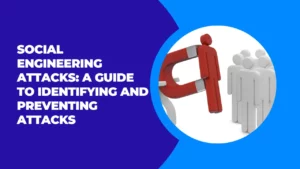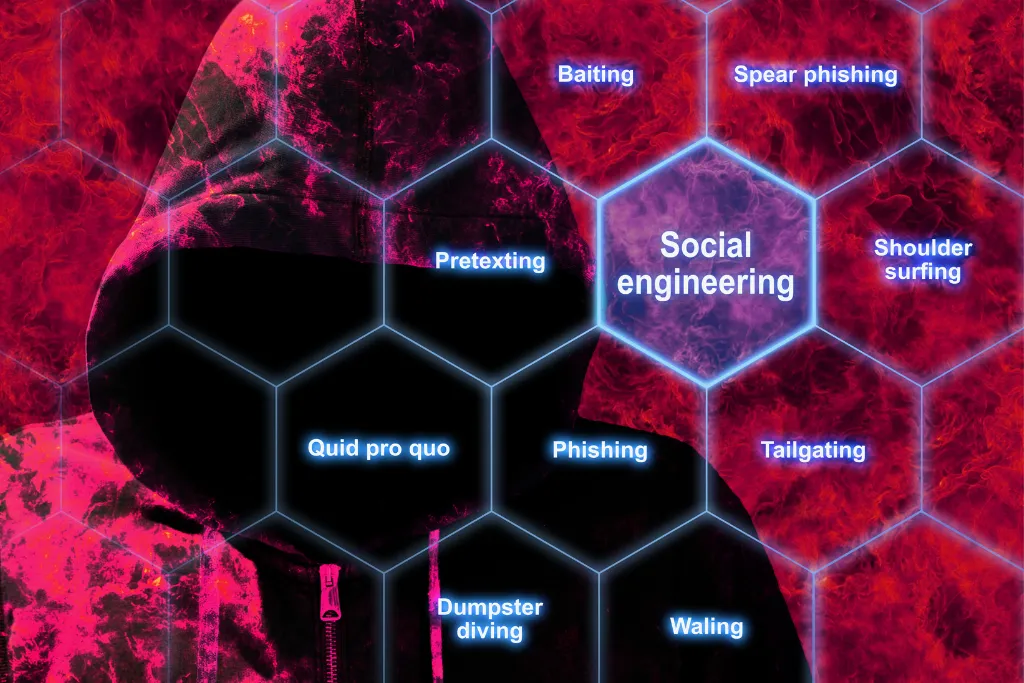Physical Address
304 North Cardinal St.
Dorchester Center, MA 02124
Physical Address
304 North Cardinal St.
Dorchester Center, MA 02124

Social engineering attacks are becoming more and more common in today’s digital age. Hackers are using psychological manipulation to trick people into sharing sensitive information or performing actions that could compromise their organization’s security.
In this blog, we will provide a comprehensive guide to understanding social engineering attacks, decoding various types of social engineering attacks, diving deep into famous examples of social engineers, and most importantly, how you can outsmart social engineers.
We will also discuss effective measures that you can take to prevent social engineering attacks from happening in your organization and whether all organizations are equally vulnerable to these attacks. Join us as we explore the world of social engineering and learn how to protect yourself and your organization from these dangerous attacks.

Social engineering, a manipulation technique that exploits human psychology, is used to deceive individuals and gain unauthorized access or information. This form of attack often involves psychological manipulation and aims to deceive and trick its victims.
Social engineering attacks can occur through various channels, such as spear phishing emails, malicious websites, or even text messages with attachments containing malicious code. Cybercriminals and hackers prey on unsuspecting individuals, targeting their personal data, financial information, and confidential details like social security numbers or credit card information.
These attackers use pretexting, creating a false scenario or pretext to trick individuals into divulging sensitive information. By understanding the concept of social engineering and its various tactics, individuals and organizations can better protect themselves against these sophisticated attacks.
Social engineering exploits vulnerabilities by manipulating human psychology. Social engineers gain trust by impersonating familiar or trustworthy individuals, using psychological manipulation tactics to deceive their targets.
These attacks prey on human emotions like fear or greed. The mechanism of social engineering relies heavily on psychological manipulation. By understanding how to exploit human vulnerabilities, social engineers can manipulate individuals into revealing personal data and engaging in risky behaviors.
To carry out their attacks, they may use various tactics, such as spear phishing, pretexting, or baiting. It is essential to be aware of these mechanisms and the tactics employed by social engineers to protect ourselves from falling victim to their schemes.
Social engineering attacks are highly effective due to their ability to leverage inherent human traits and tendencies. These attacks exploit the elements of surprise and urgency, which increases their effectiveness.
Social engineers take advantage of individuals’ willingness to help or comply, manipulating them into divulging sensitive information or performing actions that they normally wouldn’t. Moreover, the lack of awareness and security training makes individuals more susceptible to social engineering tactics.
Cybercriminals thrive on human error and the trust people place in authority figures. By exploiting these vulnerabilities, they can gain access to personal data and financial information and even manipulate individuals into carrying out malicious activities.
It is crucial for individuals and organizations to be aware of these tactics and implement preventive measures to protect themselves from falling victim to social engineering attacks.
Read More: Navigating Into Cyber Warfare: Key Concepts and Considerations

Phishing attacks revolve around deceiving individuals into divulging sensitive information while baiting tempting victims with the allure of something valuable. Tailgating entails unauthorized access through physical proximity, exploiting the assumption that strangers can be trusted.
Other social engineering tactics include pretexting and quid pro quo, each targeting distinct vulnerabilities to exploit. These attacks take advantage of human tendencies and manipulate emotions such as fear or greed. By understanding the different social engineering techniques, one can better protect themselves from cybercriminals seeking personal data for financial gain.
From spear phishing emails to malicious websites and attachments, it is crucial to remain vigilant in identifying and thwarting these deceptive attempts to breach security.
Phishing attacks employ deceptive emails or messages, masquerading as legitimate sources like banks or companies, to deceive unsuspecting individuals.
The primary goal is to obtain confidential information and login credentials, which can lead to identity theft or unauthorized access to personal accounts. Cybercriminals frequently exploit social engineering tactics such as urgency or fear to manipulate victims into divulging sensitive data.
Be cautious of suspicious requests for personal data, financial transactions, or confidential information, especially via email or text message. Avoid clicking on attachments or links from unknown senders, as they may contain malicious code or lead to malicious websites. Stay vigilant and employ security measures to protect yourself from falling victim to these phishing attacks.
Offering something desirable to entice individuals is the essence of baiting. This tactic often involves using free downloads, giveaways, or exclusive offers as common baits. Baiting attacks rely on exploiting curiosity or greed, hoping to deceive individuals into falling for their tricks.
Once lured in, victims may unknowingly install malware or become targets of phishing attempts. Baiting attacks can take place through various channels, including physical media or online platforms. It is essential to be cautious when encountering enticing offers or unfamiliar links to avoid becoming a victim of baiting attacks.
Staying vigilant and being aware of the potential dangers associated with such tactics can help protect personal data and prevent falling into the traps set by malicious actors.
Tailgating, also known as unauthorized entry through physical proximity, poses a serious security threat to organizations. This type of attack involves an individual following someone with authorized access, exploiting trust, and lack of verification procedures. The consequences of tailgating attacks can be severe, leading to unauthorized access to secure areas or systems.
To prevent tailgating, organizations must implement strict access control measures to ensure that only authorized individuals are granted entry. By incorporating technologies such as access cards, biometrics, and surveillance cameras, organizations can significantly reduce the risk of tailgating incidents.
It is crucial for organizations to prioritize physical security alongside other cybersecurity measures to protect against this dangerous game of tailgating.
Social engineers are adept at manipulating people through false pretenses. They employ psychological tactics to gain access to sensitive information and exploit individuals’ trust. Pretexting is a technique often used by social engineers, which involves creating a believable story or scenario to deceive unsuspecting victims.
Real-life examples of pretexting abound, showcasing the extent of manipulation employed by social engineers. Whether it’s posing as a coworker in need of urgent assistance or pretending to be a trustworthy authority figure, social engineers use pretexting to exploit human vulnerabilities and extract valuable information.
To effectively combat pretexting attacks, individuals and organizations must be equipped with techniques to identify and prevent such manipulative tactics. By staying vigilant for red flags such as suspicious requests for personal data or unusual circumstances, individuals can protect themselves from falling victim to pretexting.
Quid pro quo attacks, a technique employed by social engineers, exploit the human desire for reciprocity. In these attacks, the attackers offer something in exchange for sensitive information or access. This can come in the form of a favor, a gift, or even a promise of assistance. Once the victim provides the requested information or access, the attackers gain what they need to carry out their malicious activities.
Examples of quid pro quo attacks abound, such as a cybercriminal posing as an IT support technician offering technical assistance in exchange for remote access to a computer. Another example is a hacker pretending to be a coworker in need, requesting login credentials to access a supposedly urgent document.
To protect against quid pro quo scams, it is important to be vigilant and recognize the signs of such attacks. Employees should be educated on the techniques used by social engineers and the potential consequences of falling victim to these scams. Implementing strong security measures, such as multi-factor authentication and regular employee training, can also help mitigate the risks associated with quid pro quo attacks.
Scareware is a deceptive tactic commonly used by social engineers to manipulate individuals and create a sense of urgency and panic in their victims. These scams often involve tricking individuals into believing that their computer is infected with a virus or malware, leading them to download malicious software. The goal is to exploit their fear and prompt them to take immediate action, such as purchasing fake antivirus software or providing personal information.
Scareware attacks can have a significant impact on both individuals and organizations. They can result in financial loss, stolen personal data, and even identity theft. For instance, cybercriminals may use scareware to gain access to credit card information, social security numbers, and other confidential data. Moreover, scareware can also be distributed through various channels, including malicious websites, email attachments and text messages.
To stay safe from scareware, it’s important to be cautious and skeptical of unsolicited messages or pop-ups that appear on your screen. Avoid clicking on suspicious links or downloading software from untrusted sources. Regularly update your antivirus software and use strong, unique passwords for your accounts. Additionally, be aware of common scareware tactics, such as urgent warnings, false claims of infections, and requests for sensitive information.
By staying informed and practicing good cybersecurity hygiene, you can protect yourself and your personal information from falling victim to scareware attacks. Stay vigilant and remember that prevention is key to outsmarting social engineers.
Watering hole attacks pose a significant threat to targeted groups, using compromised websites to infect visitors with malware. These attacks have been responsible for high-profile incidents in the past.
To protect against watering hole attacks, it is crucial to stay vigilant online and employ robust cybersecurity measures. By understanding how these attacks work, individuals can better defend themselves against this type of social engineering attack.
It is important to recognize that cybercriminals are constantly evolving their tactics, making it necessary for users to remain educated and informed about the latest threats. Being cautious while browsing the internet, avoiding suspicious websites, and keeping software up to date are effective ways to mitigate the risk of falling victim to a watering hole attack.
Diving deep into famous examples of social engineers allows us to examine the tactics and techniques utilized by these individuals. By studying case studies of well-known social engineering attacks, we can understand the impact they have had on both individuals and organizations.
These incidents serve as valuable lessons, highlighting the need for enhanced security awareness. Applying the knowledge gained from famous social engineering incidents enables us to prevent future attacks and protect our confidential information. It is crucial to stay informed about the strategies used by social engineers, such as spear phishing, pretexting, and business email compromise (BEC).
By being aware of their methods, like sending phishing messages or creating malicious websites, we can avoid falling victim to their scams. By studying the actions of infamous social engineers like Susan Headley, Mike Ridpath, and the Badir Brothers, we gain insights into their devious techniques and enhance our ability to outsmart social engineers.
In the intriguing case of Susan Headley, we delve into a detailed analysis of her social engineering tactics. Headley employed various methods to gain access to sensitive information, using her cunning and manipulation to deceive unsuspecting individuals.
The consequences of her actions were significant, highlighting the need for organizations to be vigilant and proactive in defending against similar social engineering attacks. One of the key takeaways from this case is the importance of employee training and awareness in preventing insider threats.
By educating staff on the risks and providing them with the tools to recognize and report suspicious activities, organizations can significantly strengthen their defense against cybercriminals. Protecting against social engineering requires a multi-layered approach that encompasses not only technological safeguards but also a culture of security consciousness among employees.
Mike Ridpath, an infamous social engineer, has perfected the art of deception. His manipulative tactics have had a profound impact on both individuals and businesses, leaving them vulnerable to his attacks. By analyzing his methods, organizations can identify vulnerabilities and enhance their security measures to prevent falling victim to similar schemes.
One of Ridpath’s preferred techniques is spear phishing, where he carefully crafts targeted emails to deceive recipients into divulging personal information or clicking on malicious links. He also leverages pretexting, creating elaborate scenarios to extract sensitive information from unsuspecting victims. Additionally, he exploits the trust placed in coworkers, using their identities to gain access to confidential information.
To mitigate the risk of such attacks, organizations must prioritize security awareness training to educate employees about the dangers of social engineering. Implementing strict access controls, such as two-factor authentication, can also provide an additional layer of protection against unauthorized access. Incident response and recovery plans are crucial in minimizing the damage caused by social engineering incidents, allowing for swift action and containment.
By understanding the deceptive techniques employed by social engineers like Mike Ridpath, organizations can proactively enhance their security measures, safeguarding themselves from the ever-evolving threat landscape.
Exploring the notorious exploits of the Badir Brothers, cybercriminals who masterfully utilized social engineering to execute widespread fraud schemes. These brothers employed various tactics to deceive their victims and gain access to personal data and financial information.
The consequences of their actions were far-reaching, leading to significant financial losses and legal repercussions. To protect themselves from similar scams, organizations must implement strategies such as ongoing security awareness training and regular risk assessments.
By educating employees about the dangers of social engineering, organizations can enhance their resilience against malicious attacks. Additionally, implementing robust security measures, such as securely managing USB drives and safeguarding sensitive information, can further mitigate the risk posed by cybercriminals.
Protect yourself from social engineering attacks by staying vigilant and cautious of suspicious emails or messages. Regularly update and strengthen your passwords, avoid sharing sensitive information on public platforms, and be aware of common social engineering tactics. Educate yourself and your employees about these attacks to stay one step ahead of the social engineers.
To effectively prevent social engineering attacks, organizations should implement multi-factor authentication as an added layer of security. Regular security awareness training for employees is crucial to educate them about the tactics used by hackers and cybercriminals. Using strong encryption methods to protect sensitive data can help safeguard against unauthorized access.
Additionally, regularly updating and patching software and systems helps to address any vulnerabilities that could be exploited by attackers. Monitoring and analyzing network traffic for any suspicious activity can help detect and prevent social engineering attacks before they cause damage. By implementing these measures, organizations can significantly reduce the risk of falling victim to social engineering attacks.
The level of vulnerability to social engineering attacks varies among organizations based on their security practices. Small businesses with limited resources may be more susceptible, while high-profile organizations are often targeted for the potential for greater rewards. Weak cybersecurity measures also make organizations more vulnerable. Social engineering attacks can target both individuals and organizations.
In conclusion, social engineering attacks continue to pose a significant threat to individuals and organizations alike. Understanding the concept and mechanism of social engineering is essential in order to identify and prevent such attacks.
By decoding various social engineering techniques, including phishing, baiting, tailgating, pretexting, quid pro quo, scareware, and watering hole attacks, we can better protect ourselves and our businesses. It is crucial to stay informed about famous examples of social engineers and their tactics, such as Susan Headley, Mike Ridpath, and the Badir Brothers.
Implementing effective preventive measures and ensuring awareness among employees can help outsmart social engineers. However, it is important to note that no organization is immune to social engineering attacks, and constant vigilance is required to stay one step ahead of these threats.